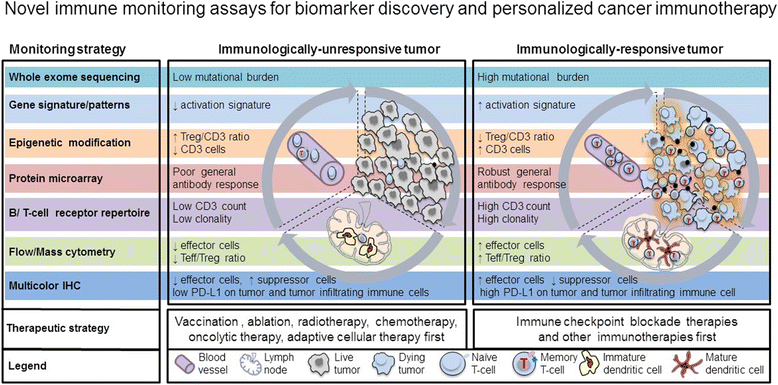Novel technologies and emerging biomarkers for personalized cancer immunotherapy
- PMID: 26788324
- PMCID: PMC4717548
- DOI: 10.1186/s40425-016-0107-3
Novel technologies and emerging biomarkers for personalized cancer immunotherapy
Abstract
The culmination of over a century's work to understand the role of the immune system in tumor control has led to the recent advances in cancer immunotherapies that have resulted in durable clinical responses in patients with a variety of malignancies. Cancer immunotherapies are rapidly changing traditional treatment paradigms and expanding the therapeutic landscape for cancer patients. However, despite the current success of these therapies, not all patients respond to immunotherapy and even those that do often experience toxicities. Thus, there is a growing need to identify predictive and prognostic biomarkers that enhance our understanding of the mechanisms underlying the complex interactions between the immune system and cancer. Therefore, the Society for Immunotherapy of Cancer (SITC) reconvened an Immune Biomarkers Task Force to review state of the art technologies, identify current hurdlers, and make recommendations for the field. As a product of this task force, Working Group 2 (WG2), consisting of international experts from academia and industry, assembled to identify and discuss promising technologies for biomarker discovery and validation. Thus, this WG2 consensus paper will focus on the current status of emerging biomarkers for immune checkpoint blockade therapy and discuss novel technologies as well as high dimensional data analysis platforms that will be pivotal for future biomarker research. In addition, this paper will include a brief overview of the current challenges with recommendations for future biomarker discovery.
Keywords: Bioinformatics; Biomarkers; Cancer immunotherapy; Immune checkpoint blockade; Immune monitoring; Task Force; Technology.
Figures

References
-
- Ehrlich P. Ueber den Jetzigen stand der Karzinomforschung. Ned Tijdshr Geneeskd. 1909;5:273.
-
- Thomas L. Cellular and humoral aspects of the hypersensitive states. New York: Hoeber-Harper; 1959.
Publication types
Grants and funding
LinkOut - more resources
Full Text Sources
Other Literature Sources
Research Materials
